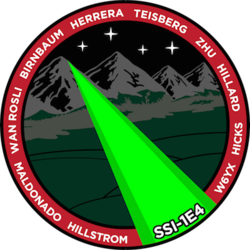SSI-1E4
| SSI-1E4 | ||||
|---|---|---|---|---|

| ||||
| Test date | June 4, 2015 | |||
| Transmit Location | Skyline Boulevard Overlook | |||
| Receive Location | W6YX | |||
| Link Distance | 10 km | |||
| ||||
SSI-1E4 was SSI's first successful 10km optical link test, which used OpComms System III. The test followed an unsuccessful attempt the previous night, which was inhibited severely by fog levels in the mountains. The team drove to the test sites much earlier than usual, getting there in time to set up during daylight, and began transmitting as dusk fell in the hopes of establishing a link before the fog became significant. With cooperation from the weather and some on-site revision of the rigs, the test was successful, with the receive team able to clearly see the binary signal sent by the transmitter.
Targeting and Alignment
Prior to heading up the mountain, the transmit team spent some time identifying nighttime landmarks from a picture taken on an earlier test to use as calibration references for the team's alignment software. Airports were chosen as reference targets as they tend to have very specific and recognizable light patterns; in particular, evenly spaced lines of lights along runways and bright flashing lights on top of signal towers indicate active airspaces. Almost all of the actively lighted airports in the area on both sides of the San Francisco Bay were identified in order to give flexibility in selecting points in case visibility in some areas was compromised.
In order to see these markers, the transmit team needed to wait for darkness, but after some orientation, they were able to correctly identify several of the local airports through the alignment telescope. Using these points, the team was able to successfully align the transmitter to within several meters of its target, the amateur radio club in the Stanford Dish preserve (W6YX). A flashing red LED beacon at the receive station was clearly visible through the telescope optics of the transmitter, confirming this alignment. This was the first true test of the team's pointing algorithm across 10km, and it seems to have worked with a reasonably high degree of accuracy, finding a correct heading faster and more accurately than manual alignment procedures.
Use of a Green Laser
Although a rough heading was established, the receive team initially ran into some problems with finding the exact location of the laser spot. It is suspected that the low density fog contributed significantly to the attenuation of the blue laser beam, because the spot, when finally identified, was very faint and highly variable due to scintillation.
The teams conferred and decided to test out a green laser source instead, which proved much more visible from the receive side. Although it should be noted that some part of this observed increase in intensity likely derives from the human eye's bias towards perceiving green light, the change in spot visibility on the ground was drastic, leading the teams to believe other physical properties were at play. It remains an open question as to why the green laser cut through the fog so much more effectively.
Results
Once the switch to a green laser had been made, the transmit team was able to make fine adjustments to the heading in order to send light directly into the fresnel box receiver. The receive team focused the receiver optics to direct as much light as possible into the photodetector, and were able to detect a very noisy but clearly visible signal. By manually interrupting the beam at the transmit site, we were able to see a clear delineation between on and off states in the oscilloscope. The receive team experimented with adding a 50 ohm inline terminator to the receiver, but found no noticeable effects on improving signal to noise ratio. Without the terminator, which tended to decrease the overall power through the system, the signal was approximately 10mV.
The strategic choice to set up earlier in the evening paid off for the team, as it seemingly allowed the test to have narrowly avoided the thick late-night fog in the mountains. In all, the test was a great success for the Optical Communications group, with the pointing algorithm working reasonably well, and data transmission clearly established over the link. This test indicated that much would need to be done to improve the system to the precision necessary for a 100km test, the team's next milestone, but success at the 10km distance has demonstrated that many of the technical hurdles have a reasonable chance of being surmounted.